Do you want to change the color of the interior in the apartment? Do you want to paint the walls yourself, ? Do you want to know what is proper wall painting? Even today, painted walls, despite the huge variety of finishing materials, are very popular.
The secret to the longevity of the painted wall trend is not complicated at all: low price, relative durability and ease of operation. Is it possible to produce high-quality painting without the involvement of specialists? High-quality wall painting will not be a real problem for you if you follow simple tips on how to do it right.
Preparing to paint the walls.
The walls in the room we want to renovate must be properly prepared for painting. The walls to be painted must be smooth, dry, without cracks and chips. If necessary, putty the walls for painting and you will not think about it.
Before we start painting, it is recommended to use a primer. Applying a primer to walls before painting is ideal for covering an old color with a new color without having to paint multiple coats. In addition, this ensures uniform coloring of the walls and significantly saves paint consumption.
It will be optimal to take out all the furniture from the room in which the walls will be painted. However, if there is a lot of furniture, or moving it is problematic, cover the furniture with a film for safety. Same before do-it-yourself wall painting it is recommended to cover the floor with a film and the floor in the room. This will protect it from splashing or staining.
The content of the article:
Textured wall painting is a view decorative finishes, which allows you to create relief patterns on the surface of structures due to the density of the material used. With the help of textured paint, you can not only decorate the walls, but also mask their minor defects. The color of the material is easy to change by adding acrylic pigments to it.
Advantages and disadvantages of textured coatings
The main difference between textured paint and its “smooth” counterparts is the aesthetic component, which helps to give the walls a beautiful and amazing effect. Coatings based on decorative paints have a lot of advantages, which is the reason for their wide popularity:
- The average service life of a textured wall covering is 10 years, while wallpaper can last no more than 5 years. In addition, burnt or worn canvases will have to be removed and replaced with new ones, and the textured coating can simply be refreshed with a new layer of paint. This greatly simplifies repairs and saves time.
- Decorative textured coatings do not fade from exposure to sunlight, have sufficient mechanical strength and are not afraid of mold.
- The surface of the walls, painted with such material, has a monolithic appearance, creating a harmonious single picture.
- The textured coating is easy to clean, and it is much more difficult to put a stain on its surface than on paper wall wallpapers, which often quickly get dirty in corners and around switches.
- The choice of design effects and a variety of shades for textured wall painting water-based paint so huge that it will satisfy any pretentious designer and amaze the homeowner inexperienced in this matter. When applying layers of textured paint using spatulas and special rollers, you can feel like a skilled craftsman, experimenting with texture and colors. Due to its diversity, decorative coatings fit perfectly into almost any interior.
- Textured water-dispersion paints, being completely safe for health, will perfectly fulfill their purpose in children's rooms. Coatings do not contain carcinogens and do not cause allergy attacks.
- The materials are universal, they can be used in the design of kitchens, respectable living rooms and bright rooms for children with equal success. Moisture resistance of textured paints allows them to be used for facade work and bathroom walls.
- Antistatic decorative coating does not absorb dust.
- Each textured coating applied to the wall is unique. In this it differs from wallpaper, the mass production of which often makes the walls of different apartments the same. When working with decorative paint, every time you get something original, application special technologies makes it possible, using the same bucket of paint, to achieve completely different effects.
- The textured coating looks natural and rich on the surface of the wall, which transforms an ordinary apartment into a beautiful cozy home.
- Despite the sufficient thickness, the coating has good permeability and does not create obstacles for air circulation in the premises.
Another disadvantage is the increased material consumption, which is 1 kg / m 2 of walls, this circumstance significantly affects the cost of the coating, causing it to become more expensive.
Decorative Effects of Textured Wall Paints

Textured paints that can transform rooms due to their design special effects are very popular today:
- pearly effect. Such paints make the room lighter, which is especially important in cloudy weather in the autumn-winter period. At different angles and types of lighting, the pearlescent coating has the ability to change color, for which the material received the name "chameleon paint". The walls painted by her look like a stretched silk cloth.
- Velvet or velor effect. The composition of such paint includes colored solid particles. The wall treated with this material has the appearance of a velor fabric - the same textured, soft and deep.
- granite paint. Contrary to its name, it does not have granite chips. The impression of its texture is formed by acrylic bubbles of paints of different shades, which are broken when applying the material to the wall with a spray gun.
- Textured decorative paints . They contain fragments of shells, mineral particles, fine sand and other additives. Each type of such ready-to-use paint gives its own special effect: a shiny and embossed surface, a coral wall, a seascape, etc.
Preparing walls for texture painting

You should start painting the walls by protecting the flooring and ceiling with a film from unwanted ingress of dust, debris and splashes of material on them in the process of preparing and decorating surfaces. The film can be fixed with masking tape.
Before texture painting the walls, it is necessary to remove the old finishing material, rust, mold and grease stains from them with all mechanical devices and chemical means suitable for this purpose.
After that, it is necessary to seal the cracks on the walls and level the surfaces to be painted, plaster or putty.
After the walls have dried, they must be treated with a penetrating primer to create adhesion of materials to the base and reduce paint consumption for finishing. The primer should be applied with a paint roller.
Five hours after priming, you can start working with textured paint. It must be mixed well and add pigment desired color. To facilitate the staining process, the material can be slightly diluted with water, but its volume should not exceed 1% of the weight of the paint.
The technology of applying textured paint on the walls

The job of painting walls is similar to the process of puttying. It is performed in various ways. The common point for them is that the paint is applied to the surface of the walls with a wide spatula, with which an area of \u200b\u200bno more than 2 m 2 is processed. The corners of the walls are painted with a narrow spatula.
A small amount of textured mixture is taken on a spatula, and then applied to the surface of the wall. Then, with the help of various devices, it is given the desired texture. After a couple of hours, the paint will begin to stick to the wall and dry completely after two days. Only after the end of this process can acrylic, varnish or wax be applied to the surface.
Drawing a picture during textured painting of walls can be done manually or a stencil can be used for this purpose. Relief is applied to a monochromatic coating by rolling it with a cloth or by tapping it with a brush having a hard bristle.
Fantasy can suggest any ideas for applying patterns. It can be waves, tree branches or various shapes. To give the painted surface a relief, you can use a variety of improvised materials.
Ways to create a textured pattern on the walls

Applying a textured pattern to the surface of a painted wall can be a difficult task for an inexperienced person. Therefore, it is advisable to first practice on a specific section of any plane. This will help to acquire the skill and avoid the cost of reworking the finished work.
When painting walls with textured paint with your own hands, you can use various methods to create a relief:
- Using a foam roller. Textured paint white color must be applied to the wall and leveled with a wide spatula. Then the surface should be rolled with a roller, giving it the desired structure. A day later, it is required to apply pale blue paint to the texture, and carefully remove its remnants with a foam rubber sponge. For the final finish, the dried surface of the wall must be treated with a grater, the resulting dust removed with a dry brush and the finishing layer of mother-of-pearl enamel applied to the coating using a fine-nap roller.
- Using a trowel. In this case, it is necessary to apply two layers of light brown textured paint to the wall, the first of which is applied with a spatula, and the second with a trowel. A day after the surface has dried, it should be painted with white matte enamel using a fur roller.
- Using a rubber roller. With this method, the material must be applied to the wall with a wide spatula, and then with a rubber textured roller to paint the walls to create the desired pattern.
If you use a piece of newspaper in a plastic wrap as improvised means or hit a freshly painted coating with a wet rag, you can give it an original and interesting design.
Two-tone textured wall painting

With the help of textured paint, two-color drawings can be made. This type of wall decoration has become very popular. For example, on fresh paint, you can make various strokes with a sharp object, and then immediately, before it dries, with a mixture of a different color using a stencil, make a new drawing on the wall. The result will decorate its appearance.
Clear outlines of geometric patterns will look good on the wall. In order to make textured wall painting with such a pattern with your own hands, you need to attach a masking tape to a fresh solution to get an imprint on it. Then you need to apply paint of a different color to the tape.
The most effective and simple method of creating a two-color coating is to scratch the surface that has not yet dried with a stiff bristle or comb teeth. The best effect is achieved with a chaotic arrangement of scratches.
How to paint walls with textured paint - look at the video:
All these methods of textured wall painting are just a small fraction of what can actually be done. There are a lot of similar options that are subject to the master and depend on his imagination and the available tools at hand. Textured painting allows and encourages experimenting with patterns and colors in order to obtain interesting patterns of wall coverings that give interiors an unusual and attractive look. Good luck!
The emergence of such an interesting finishing material as textured paint made a splash in the construction market due to its bright color and unique structure created on the surface. Such a simple and technologically thought-out coating immediately gained popularity.
But the question remains of how the factory and textured do-it-yourself paint differs from the usual types of paint and varnish coatings?
What is texture paint?

Do-it-yourself or factory-made textured wall paint is a material that allows you to create a non-uniform relief coating. The scope of this type of finish is very diverse. Such surfaces can decorate the facade, as well as rooms.
Application instructions provide for the possibility of creating a decorative coating on the following types of substrates:
- Concrete;
- Plaster;
- Brickwork;
- Wood.
Note!
If finishing any metal elements of the interior is necessary, then it is more expedient to use products such as fire-retardant paints for metal Polystil or electrically conductive paint Zinga, which creates a coating that protects the surface from rust.
In fact, textured paint is a homogeneous mass of snow-white color, which contains a filler of a thick consistency. It is this very filler that allows using this material to create surfaces that imitate various reliefs. It is these properties that distinguish structural finishing masses from acrylic or latex-type compositions.
Classification of textured material

A large assortment of embossed paint coatings on the modern market suggests a classification.
Conventionally, compositions of this type last depending on the size of the filler present in the composition:
- Fine-grained (0.5 mm or less);
- Medium grain (0.5-1 mm);
- Coarse-grained (1-2 mm).
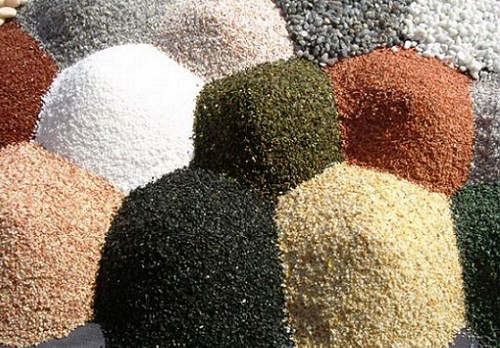
Structural paint products in their composition as a filler may contain the following products:
- stone chips;
- Quartz dust:
- Synthetic fibers;
- Gas silicate crushed or crushed;
Self-made textured paint
Special attention deserves the material prepared by oneself. But how to make textured paint with your own hands?
For cooking you will need acrylic paint for indoor or outdoor use, depending on which surfaces need to be painted. It is mixed with granite crystals, which can be purchased at any hardware store and are inexpensive.
You can also mix paint with sand to create relief. This coating will create a surface that resembles colored sand.
Advice. You should not experiment and use sea or river sand, this will not lead to anything good.

Texture painting technology
What kind of relief will be created on the final coating directly depends on what application technique was used in the work.
Do-it-yourself textured wall painting can be done using the following tools:
- Metal combs;
- natural sponges;
- Structural rollers;
Advice. Before proceeding with the application of a relief coating, it is necessary to apply a deep penetration primer to the surface.
In addition to the tool with which the application is carried out, the composition also plays an important role.
To give the coating greater relief, quartz sand or sawdust is added to the mass.
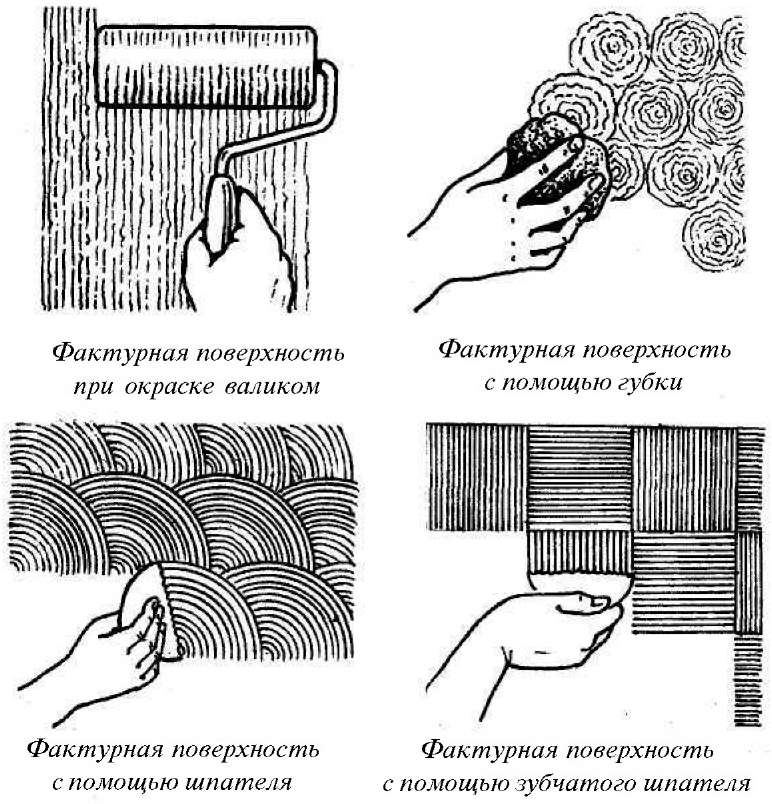
- Brush painting.
For this better fit wide brush. With such a tool, the composition is applied to the prepared walls with wide strokes in any direction; - Roller processing.
You will need three rollers, two large, of the same size, and one small. With a large roller, the mass is applied to the surface, hard-to-reach places are processed with a small one, and irregularities or too large spots of paint are removed with a clean large roller; (See also the article.)
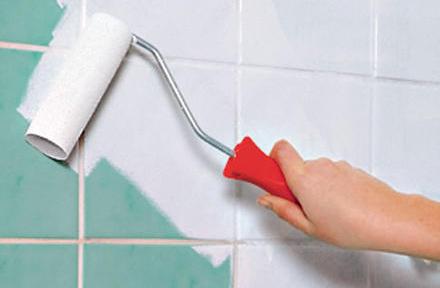
- Spray finish.
There are formulations that are sold immediately in a spray bottle. When applying the material in this way, you must be very careful, because it is quite difficult to control the thickness of the layer; - Sponge work.
The sponge opens up great creative possibilities, because it allows you to use various stencils in your work. Sponges can literally draw on the surface, creating a relief.
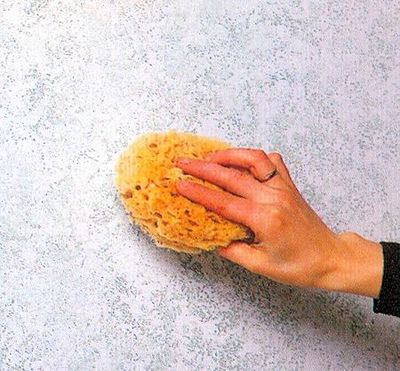
The main pros and cons of textured paints
If we compare given type paints with other paints and varnishes, the following advantages can be distinguished:
- Textured coating can be applied to the surface immediately, eliminating the long and costly leveling procedure. The relief coating makes the walls uniform and hides cracks, dents and irregularities in the base;
- The textured layer is resistant to various kinds of mechanical damage, which expands the scope of this type of compositions;
- Low price, combined with a huge variety of textures and color options;
- This type of paint is applied quite easily and quickly.
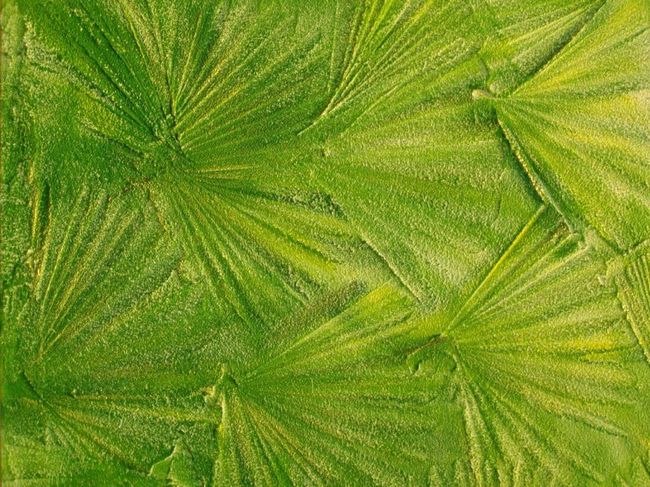
The disadvantages of textured coating include the following points:
- Relief coatings for their creation require 15-30% more material than conventional painting;
- The surface can be repainted only after the first layer of coating has been completely removed.
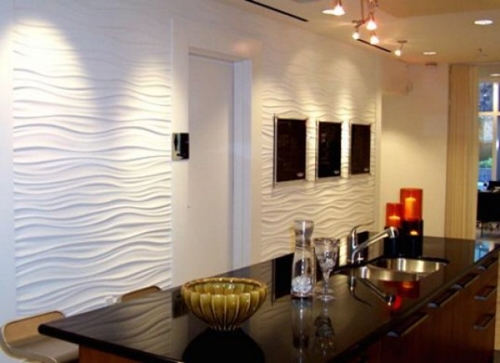
Do-it-yourself textured wall paint is a great opportunity to make high-quality and beautiful interior decoration without leveling the walls. You can create original and bright design facade or room, spending a minimum of effort and time. And the variety of colors, shades and different grain sizes of the filler will make it possible to realize even the craziest design idea.
Even more important information how to do it right, you can learn from the video in this article.
Exquisitely and tastefully finished walls are a very important element of decor for any room. Almost all existing finishing materials have some drawbacks that limit their use, especially in indoor areas, which require not only beauty, but also safety and environmental friendliness. Therefore, the optimal material for the interior, and exterior finish walls is textured paint. Only it allows you to create incredibly chic, bewitching surfaces on the walls, allowing any manifestations of your own, even the richest and irrepressible imagination.
The process of working with textured paint is incredibly simple and easy, so it can be used by people with a complete lack of experience in construction and finishing works. Distinctive feature of ongoing painting work can be considered the possibility of creating your own textures, as well as sufficient time to correct what you did not like or did not work out. To hone your “mastery”, you can practice on a piece of plywood or a small section of the wall (in this case, before the main painting, the “training” composition of the textured paint must be completely removed with a steel spatula, and the wall must be dried and primed).
Textured wall paint has undeniable advantages over other materials, and among the main ones are the following:
- frost resistance;
- resistance to constant exposure to UV rays;
- the plasticity of the resulting coating, which does not allow the wall to become covered with small cracks (with natural shrinkage of buildings);
- insensitivity to dampness, preventing the formation and reproduction of the fungus;
- finished surface does not absorb odors at all;
- dust and dirt-repellent properties, facilitating subsequent care;
- high environmental friendliness, making it possible to use in children's rooms;
- possibility of use for any reason - from brickwork up to the tree;
- huge scope for creativity when it is self-applied.
In addition, it is worth noting its hypoallergenicity and minimum requirements to the quality of the surface used for applying textured interior paints.
Applying textured paint
Textured wall paint is applied, according to reviews, extremely easily, and the use of any complex special tool is not required. Do-it-yourself textured wall paint can be somewhat modified, which will allow you to create your own, unusual textures. So, to obtain a rough relief surface, pure sawdust can be added to the paint, and quartz sand is added to obtain a structure with sharp edges. The paint is applied in a fairly thick layer, so it perfectly covers all the cracks, chips and small irregularities on the wall.
The choice of application tool is devoid of any standards, and depending on what effect you want to achieve, you can use:
- natural sponge;
- textured (structural) roller of various lengths and diameters;
- comb;
- putty knife.
In general, applying textured paint is possible even with your hands, since it is absolutely safe, and the decor created “by hand” can become quite unexpected, interesting and unique.
A little about applying textured paint with a roller is shown in the video
Variants of possible reliefs
Textured painting of walls with water-based paint allows you to get several basic textures.
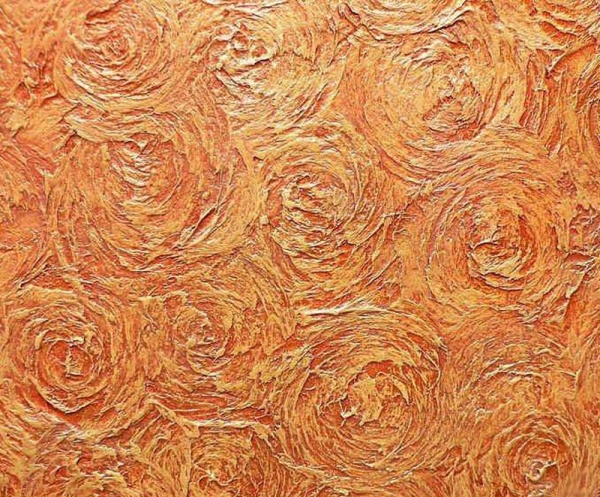
Stages of work
Applying textured paint with a roller, of course, is neither particularly difficult nor time-consuming surface preparation - and this is its huge advantage. However, the minimum amount of work to be done is still required:
- it is advisable to tap the wall with a hammer, which will reveal areas where the old plaster is about to fall out (this must be eliminated);
- large cracks need to be repaired;
- the entire surface intended for painting the walls in the apartment with textured paint should be primed with an acrylic primer, preferably marked "deep penetration".
Advice ! Best results are achieved when the applied compound and base are at room temperature.
Before working with such paint, it requires very thorough mixing, and it is better if a drill with a mixer nozzle is used for this. Re-mixing is necessary after adding the selected filler and color. There are several mandatory rules, otherwise the effect may differ from what was intended:
- the application of textured paint should be carried out in a thick enough layer to be able to create the intended texture;
- it is desirable to work immediately on the entire surface where the texture will be created, since during breaks in work places of “joints” may be noticeable, which will visually worsen the impression of the whole work;
- the tool that is planned to be used must be prepared in advance;
- after drying, textured compositions for walls with effects can be additionally painted with acrylic compositions.
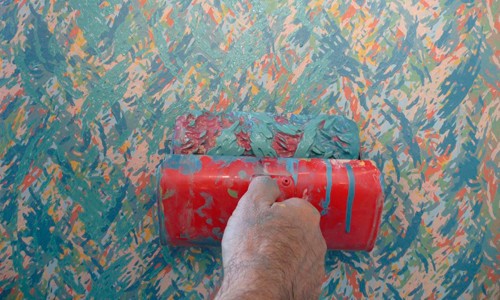
Choosing the best textured paint
Painting the walls with textured paint allows you to get a unique, sophisticated interior. With this, now no one argues. But in some cases, people complain that instead of unprecedented beauty, it turned out completely different from what they expected. In almost every such fact, the buyers themselves are to blame, who did not have a clear idea of \u200b\u200bwhat they ultimately wanted to receive. If almost everyone understands how to work with textured paint, few know about the intricacies of its choice.
Each coloring composition to give the wall texture and relief has its own graininess. The more pronounced and deep the texture is required, the greater the grain size should be chosen, and since each manufacturer marks this parameter in its own way, do not neglect the seller's advice when buying. Another important parameter of textured coatings is the base.
- Mineral. Most a budget option, consisting of cement and lime, and produced in the form of a dry powder. Most often, with the help of a mineral composition, they give texture to the outer walls of buildings.
- Silicone . The most common option that can be used both inside and outside buildings. Creates a vapor-permeable coating that is resistant to moisture, temperature extremes and aggressive environments.
- Silicate. The most expensive, but very practical option. such a coating is not afraid of any exposure to the atmosphere, the treated surface does not absorb dirt and dust, and is easy to clean. Use is allowed only in combination with a primer on a similar basis.
- Acrylic. The most convenient, ready-to-use composition that allows tinting and the introduction of the required fillers.
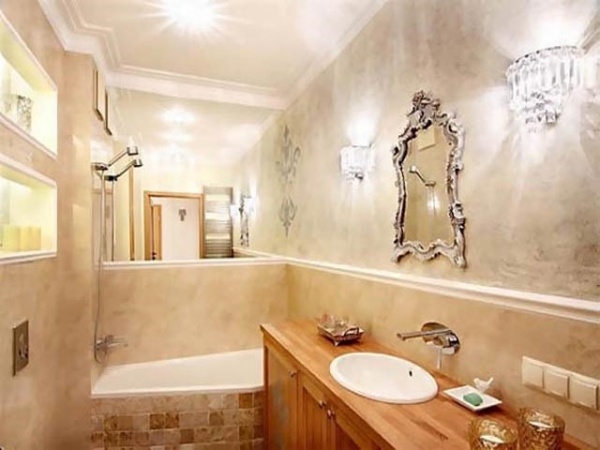
Enthusiastically engaged in the creation of a new, creative interior of your own home, you should not forget that in any business you need, if not experience, then at least skill, so training is necessary before work. In addition, you first need to be very clear about what kind of surface you want to get. To do this, you can not only look at online photo galleries, but also try to draw your future interior.
You can apply textured paint to a separate area, and using various tools or improvised means, see what kind of texture is obtained. It is important to understand that a pattern that looks good in a small area may not be appropriate on the entire wall. In addition, do not forget that all tools used to work with textured paint must be clean. Naturally, elementary safety requirements cannot be neglected - personal protective equipment and sufficient ventilation of the room will not interfere.




















